Modern flood management
How to deal with the risk?
Modern flood management is based on a 3-pillar model, the integration of which allows comprehensive protection for people and capital.
Precaution is manifested here as an important element of a comprehensive protection concept, as no effective damage mitigation can be conducted without corresponding preventive measures in the catchment area and distinct risk awareness on the part of the population.
Structural/technical flood protection should be seen as the “second best solution” although it is unavoidable in most cases. Areas at risk of flooding are often also attractive building land, now home to many people and inestimable material assets. Renaturation of such areas is inconceivable and therefore not an economically viable solution. In such cases, structural flood protection must be created by construction in order to protect these assets.
The third component – integrated management in the case of deployment – is vital. The potentials from the aforementioned elements come together here and are combined through an effective deployment organisation.
Good co-operation between all stakeholders involved, such as disaster management services, rescue services, companies, citizens and many others, is an essential requirement and should be practised continually as far as possible.
On our site, you can find information about the options for flood protection, about functions, procedures and technical basics. Using our case studies, you can find out more about operational flood protection and gain an idea of how the risk is handled in the Rhine catchment area.
Precautions
Which flood precaution strategies are available?
Economic development and increasing urban development pressure have resulted in the frequent use of river flood plains as residential areas.
The protective effect of technical flood defences such as walls, dykes and flood retention facilities works only up to the respective basis flood. Floods above this overrun the protected areas and damage is caused. Absolute flood protection can therefore never be guaranteed.
Because of the potential risk of an extreme flood in excess of the protective devices, preventive flood protection is of great relevance. This is divided into the following components:
Retention potential
In addition to natural hydrological influencing variables such as precipitation quantity of snowmelt, there are other factors that affect a flood wave and moreover represent an interface to environmental protection.
The retention of water in the catchment area slows the flow of precipitation into the outlet channels and thus reduces the maximum magnitude of a flood event. Rapid rising of streams/rivers with smaller catchment areas can therefore be slowed down and the risk of overlapping flood waves can be reduced, particularly in larger rivers.
On the following pages, you can find out about the retention potential of:
- Vegetation
- Soil
- Sealing
- Topography/relief
Precautionary behaviour
People who live and work within the immediate vicinity of a river should be aware of the risk of flooding. As soon as the terrible images of a flood event have disappeared from people’s heads, awareness of the danger decreases rapidly. Constantly maintaining this awareness also contributes to the behaviour of the citizens being adapted so they are able do the right thing in an emergency situation.
Information, education and preparation are necessary so every person affected knows the options for action and can contribute effectively to reducing the damage.
Land use provisions
Effective preventive flood protection is characterised by effective land use provisions, which determine both the nature and the extent of use for building development on flood plains. To reduce the risk of flooding in densely populated areas, the river must first be given as much expansion area as possible in order to be able to level out the maximum of the flood wave. Deliberately keeping relevant areas clear is therefore an important element of damage reduction.
Risk provision
The objective of risk provision is to limit the extent of the damage and damage loss in the case of very rare events. Hazard defence, disaster prevention and – in the absence of state aid – insurance companies serve this purpose.
In the event that flood damage occurs despite appropriate precaution and defence measures, private reserves or taking out insurance will help to lessen the economic consequences.
With so-called “extended elemental damage insurance”, it is possible to insure oneself against flooding and other risks. Such insurances are voluntary and may be taken out by a citizen if required. A similar consideration applies for the insurer, who is at liberty to refuse insurance cover for a customer because of the exposed risk situation.
Questions that could arise before the flooding event:
Is there a risk of flooding from groundwater?
Groundwater, which also rises in the case of higher water levels, endangers even low-lying districts that are further away from the Rhine. Even when the flood recedes, there is a risk of inundation from the still rising groundwater. You should therefore check your basement rooms more often and take precautionary measures.
Should I vacate low-lying parts of the building?
You should vacate basements, garages and lower-lying rooms sufficiently early. Ideally, do so from the outset, so there is no need to carry the same furniture several times. If necessary, organise professional help from removers.
The fire service can help only in exceptional cases! You should also continue your own contribution during the flooding period. If necessary, take leave from work and do not rely on others. Help your neighbours too!
What must I take into account when pumping out water?
During the flooding phase, the fire service essentially does not provide pumps to pump water ingress out of basements and other rooms. If you pump for yourself, please bear in mind that large differences in pressure can result in indentation of basement floors and walls. Co-ordinate with your neighbours!
How do I protect the heating system?
Protect your heating system. Switch off burners, heating appliances etc. in good time, so they can be removed in cool condition. Bear in mind: local heating engineers have a lot to do when flooding is imminent. Do not forget to close the gas valves on gas heating.
How do I secure oil tanks and power cables?
Use proper fixings (e.g. anchoring) to secure your oil tanks and power cables against lifting. To reduce the pressure in the case of rising flood water, you can also have your tanks completely filled in good time. Remove containers with used oil, chemicals, paints, varnishes, washing and cleaning agents from rooms at risk of flooding. Oils and other substances that are hazardous to water pollute not only the water and your rooms but also the surroundings and the environment. If environmentally hazardous substances leak out despite all precautions, inform the fire service immediately. Any time delay will exacerbate the damage many times over.
How can Water get into the building?
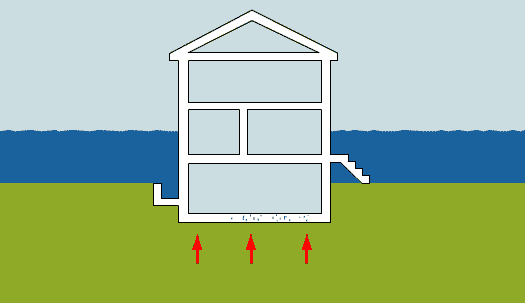
How does the Flood Water affect the Building?
If water levels are high then the groundwater rises above the level of the foundations. Water pressure and lift forces on the building arise here. Watertight buildings with few storeys do not normally have the necessary deadweight against the lift.
Measures to prevent lift
Flooding basement rooms is a short-term way to increase the weight of the house. Moreover, this equalises the pressure on the side walls. Flooding with clean water can reduce consequential damage.
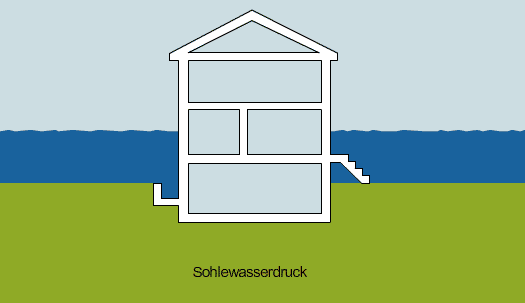
HOW DO I PROTECT THE BUILDING FROM SEWER WATER?
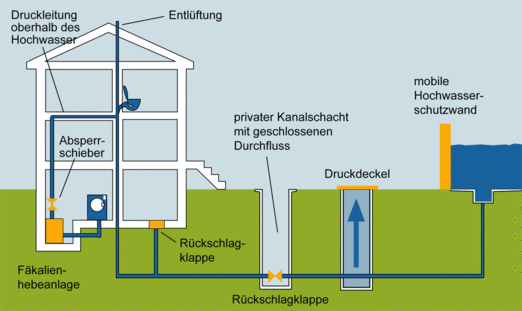
In the event of flooding, the water level in the sewer network rises, as the sewers back up in the case of overload due to large volumes of rainwater and groundwater (in the case of leaking sewers) or due to the high water level of the outlet channel. This rise in the sewer network water level continues through the outlet pipes and domestic connections, potentially into the building. If no protective equipment is in place, e.g. such as backflow traps or wastewater pumping stations, then the water level rises in the mains network of the building concerned up to the level of the water in the sewer network. This can result in water leaks from the sanitary installations or similar in the building.
How do I prevent damage to the building from undercutting?
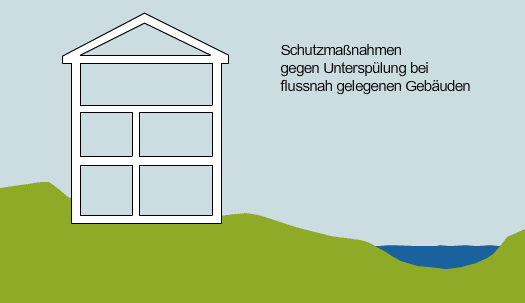
How do I protect the building from the ingress of groundwater?
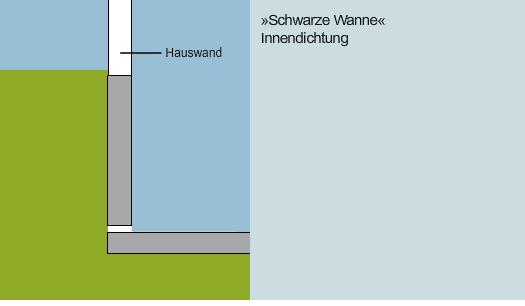
Black tank / internal seal
In the case of water-permeable soil types such as sand or gravel, a rise in the groundwater level must be expected in the event of flooding. Close to the river, it may be assumed in simple terms that groundwater level = flood level. The following animations show options for sealing a building.
Black tank / external seal
A fully enclosed seal of the building areas concerned is described as a black tank. This seal is generally implemented as an external seal with bitumen or plastic sheeting. It is technically much more difficult and expensive to apply such a seal to the inside of the building. An additional internal trough is required here in order to absorb the water pressure acting on the seal. An internal seal against water under pressure should therefore be used only in isolated cases for retrospective upgrading of old buildings.
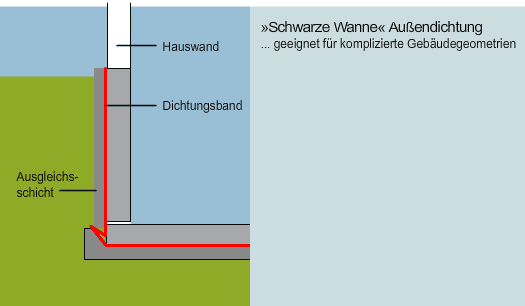
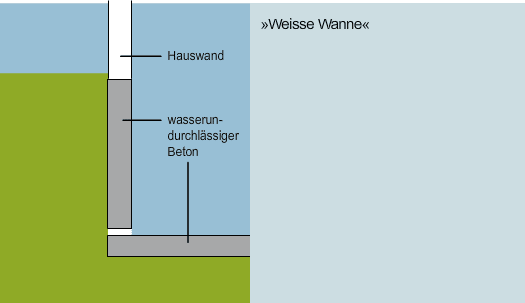
White tank
The formation of the external walls and foundation slab as an enclosed tank made of waterproof concrete is described as a “white tank”. No additional sealing membranes are required. Regardless of the nature of the seal, building floors and walls must be assessed for the expected loads from water pressure. For the reinforced concrete building floor, this generally means installation of an additional, upper reinforcing layer.
Retention potential
Water retention in the catchment area
In order to be able to operate preventive flood protection, it is necessary to depart from local-level consideration and to look at the overall problem on a regional, national and if necessary international scale. The question of flood risk of a particular area is partly determined directly by the way in which the body of water is handled going up the river. As the basic rule on a river is that “everyone downstream is upstream”, responsible handling of every kilometre of river is required and co-operation is essential when designing protective measures.
To lessen a flood, retention of rainwater in the catchment area is of vital importance. The following influencing factors affect the water level by varying degrees and can moreover contribute substantially to environmental protection through targeted support.
Vegetation
Vegetation cover must be viewed positively in three respects concerning the reduction of rapid surface runoff.
1. Interception
Organic material on the ground creates a buffer effect, which results in slowing of the flow. Depending on their surface area, plants can absorb up to 50% of the rainwater for a certain period and release it to the ground only with a delay. A small proportion of this intercepted water is returned directly to the atmosphere through evaporation, although the majority is passed to the ground/surface after a short resting period. Sealing of the ground by silting as a result of rainfall that is too heavy is therefore prevented and the storage capacity of the ground is increased.
2. Root penetration
As well as the stabilising effect of roots, they also have a substantial effect on the infiltration capacity of a soil. Dense vegetation, for example in woodlands, exhibits a significantly higher infiltration rate than open spaces or even vegetation-free arable areas. Surface runoff and therefore rapid introduction of large volumes of water into the outlet channels are therefore reduced.
3. Roughness
From a purely mechanical perspective, greater surface roughness causes a reduction in runoff speed. Vegetation creates such roughness and can equally contribute effectively to the retention of surface water.
Soil
Soils are a frequently underestimated resource, which render an exceptional service for humans (drinking water production and purification, habitat etc.) in addition to their use for agricultural production. With respect to relevance for water retention, soils have huge potential. In combination with vegetation, they form one of the largest reservoirs in the hydrological system. However, their infiltration capacity is dependent on a number of variables, which can differ both spatially and temporally. As well as pore size, the condition of the soil is particularly important:
- Frost
In the winter half year, the topsoil might be continuously or temporarily frozen and it can absorb no water in this condition. The rainfall that lands on it is entirely converted into surface runoff and results in a rapid rise in the level of the outlet channel.
- Saturation
If the soil is saturated, for example due to a previous rainfall event, then it can absorb no additional quantities of water.
- Silting
If the rainfall hits vegetation-free soil unchecked then the pores in the topsoil close within moments and no further water can penetrate through them, despite sufficient capacity in the subsoil.
As soon as the water is able to infiltrate into the soil, it percolates downward due to gravity, might be transported towards outlet channels, or eventually reaches the water table then stands in contact with the body of water as the base flow. Extensive infiltration of rainwater can sometimes delay runoff by days and is desirable in respect of preventive flood protection.
Sealing
Particularly in urban areas, the proportion of sealed surfaces is extremely high. Impeding the natural infiltration capacity of a surface by sealing (transport routes, building development etc.) directly results in an increase in surface runoff. The retention capacity of the soil, which can create a strong time delay in runoff, is completely cut off. The flowing body of water has to accommodate and discharge huge quantities of water within the shortest time, which can result in a rising water level with floods that cannot be ruled out.
Removal of sealed surfaces, for example by choosing accordingly porous paving stones, a larger proportion of green space and renaturation of smaller streams and river courses can reduce surface runoff and restart the intrinsic retention mechanisms of nature.
Topography / relief
The relief and geological structure of the near-surface subsoil determine the extent of the catchment area. The stronger the relief intensity of an area, the thinner the soil cover and with it the storage capacity of this hydrological parameter. Surface runoff therefore increases, so rainfall takes less time to reach the outlet channels.
Considered locally, small (mountain) streams can therefore grow into disproportionately large currents, which carry many times their usual volume of water into the valley. At the same time, as well as this line-based damage, extensive soil erosion occurs, which further reduces the already limited soil cover of such areas.
Moving from local to a higher level, rainfall events from which the runoff reaches the river within the shortest time therefore result in flash floods and flood waves, which might overlap with other inflows and can add up. Those who are downstream from larger catchment areas are exposed to such a risk.
Technical flood protection
Protection through structural measures
Technical flood protection is required in addition to precautionary measures, in order to protect assets and people from floods in densely populated areas. The reason for this need is the population density in areas close to rivers and coasts and the heavy development of the immediate surroundings of the body of water.
Technical solutions can be roughly classified in 2 categories:
- Retention
- Building protection
As flooding events occur not only on flowing waters but also cause massive damage in coastal areas, structural protection must also be performed here. However, this sometimes differs considerably from the aforementioned measures and must therefore be covered separately.
Retention of water for flood mitigation
Retention of water for flood mitigation
Retention
The retention of water masses also occupies a central position in technical flood protection, in a similar way to natural retention potential.
Below, you can find out more about the different options for water retention and their potential to reduce flooding.
Dams
Dams are suited to holding large quantities of water in morphologically very distinct terrain (or uplands), acting as a barrage sealing the entire transverse profile of a valley through which a water course flows. They are frequently located in the upper reaches of rivers, as the relief here offers ideal conditions with deep valleys. Nevertheless, construction of a dam on flat land is not impossible but it must be adapted to the local conditions with respect to the proportion of height & width of the arrangement.
Over time, the built up water forms a reservoir, which gradually floods broad areas of the land behind and thus reshapes previously terrestrial into aquatic ecosystems, representing a massive intervention in natural processes (a more detailed consideration of ecological consequences of flood protection measures will follow). The water can be released in a controlled way as required, holding the water level of the discharge at a constant level. The primary use of such a system frequently lies in drinking water and electricity production but it can also be used effectively for flood protection. As long as the capacity of the reservoir is sufficient, rainfall can be retained, which would otherwise have directly caused the level of the river to rise. Anticipatory control of the system is based on appropriate forecasting and can provide a very important service for flood protection.
One of the largest reservoirs in Germany is the Biggesee in Sauerland, North Rhine – Westphalia. The dam has a total height of 52 m and is 640 m wide. At 172 million m3, the volume of the reservoir is huge and it is therefore the 5th largest reservoir in Germany. For its part, the Bigge is a tributary of the Ruhr, which eventually cuts across one of the most densely populated areas in Europe and represents a significantly lower risk as a result of the control.
Retention basins
Flood retention basins play a special role in their function as a barrage. As long as a river flows along its bed at the normal water level, it crosses the structure with no problem. However, if the discharge increases above a certain limit during a flood event then the retention basin stops the excess water masses and allows only a certain basic discharge through. The lower reaches are thus protected from peak flows and receive only a calculable maximum discharge quantity.
Like dams, structures of this nature are frequently located in the upper reaches because of the topographical conditions and they serve exclusively to provide flood protection. Similar arrangements such as rainwater retention basins can be found primarily in urban sewer construction.
Special variants of retention basins are used in the Alpine area to protect against avalanches and mudslides. Structures here must withstand surges that occur suddenly and have a high solid content (trees, stones, soil material etc.), which presents particular structural demands.
